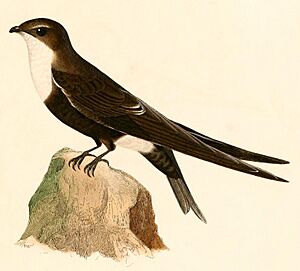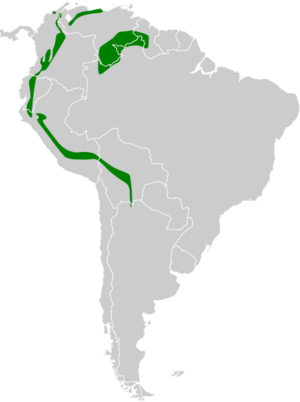White-tipped swift facts for kids
Quick facts for kids White-tipped swift |
|
|---|---|
 |
|
| Conservation status | |
| Scientific classification | |
| Genus: |
Aeronautes
|
| Species: |
montivagus
|
 |
|
| Synonyms | |
|
Micropus montivagus |
|
The white-tipped swift (its scientific name is Aeronautes montivagus) is a type of bird. It belongs to the swift family, which are known for being very fast flyers. This amazing bird lives in several countries in South America. You can find it in places like Argentina, Bolivia, Brazil, Colombia, Ecuador, French Guiana, Peru, Suriname, and Venezuela. It might also live in Guyana.
Contents
About the White-Tipped Swift
The white-tipped swift is a medium-sized bird. It is about 12 to 13 centimeters (around 5 inches) long. It weighs between 17 and 33 grams, which is about as much as a few quarters. This bird has slim, pointed wings that help it fly quickly. It also has a long tail that is slightly notched, meaning it has a small V-shape at the end.
What Does It Look Like?
Adult male white-tipped swifts are mostly dark brown. Their head and the area around their eyes are a blackish-brown color. The rest of their face is a gray-brown. Their upper body is also blackish-brown. Their tail feathers are black-brown with clear white tips. Their wings are blackish-brown, and some feathers have white edges.
The throat, sides of the neck, and upper chest are white. The rest of their underside is a slightly lighter blackish-brown. They also have white patches near their legs.
Female swifts are a bit browner than males. Sometimes, their lower back and rump are paler. The white on their throat is not as bright, and the white tips on their tail feathers might be smaller or even missing. Young swifts look similar to adults, but they have pale edges on their body feathers.
There are two main types, or subspecies, of the white-tipped swift. One is called A. m. montivagus. The other is A. m. tatei. The A. m. tatei subspecies looks very similar. However, its upper body feathers are a very shiny blue-black color.
Where Do White-Tipped Swifts Live?
The A. m. montivagus subspecies lives in the Venezuelan Coastal Range. It also lives in the Andes Mountains. You can find it from western Venezuela all the way south through Colombia, Ecuador, Peru, and Bolivia, reaching into northern Argentina.
The A. m. tatei subspecies lives in the tepui region. This area is along the border between southern Venezuela and northwestern Brazil. People have also seen this type of swift in Guyana, Suriname, and French Guiana.
Their Mountain Homes
These swifts usually live in mountain evergreen forests. But they can also be found in drier valleys between mountains, especially in Ecuador and northern Peru. They live at different heights depending on the area.
- In the tepui region, they are found between 500 and 1,900 meters (about 1,600 to 6,200 feet) high.
- In coastal and Andean Venezuela, they live between 800 and 2,600 meters (about 2,600 to 8,500 feet).
- In Ecuador, they can be found from 600 to 3,200 meters (about 2,000 to 10,500 feet). They are most common between 1,500 and 2,000 meters (about 4,900 to 6,600 feet).
- In Peru, they usually live between 1,200 and 2,400 meters (about 3,900 to 7,900 feet).
- In Bolivia, they are typically found between 500 and 2,600 meters (about 1,600 to 8,500 feet).
How White-Tipped Swifts Live
White-tipped swifts are generally thought to stay in the same area all year. However, they sometimes disappear from certain places for several months. This suggests they might move around more than we realize.
What Do They Eat?
Like all swifts, the white-tipped swift eats insects while flying. They catch their food right out of the air! We don't know all the details of their diet. But we do know they eat flying ants, beetles, and moths.
They often fly and eat with other types of swifts. But they also form their own groups, sometimes with up to 50 birds. They usually hunt for food low over the forest. If they are in canyons, they stay at the height of the ridge tops.
Reproduction and Nests
The breeding season for white-tipped swifts in Venezuela seems to be from April to July. We don't know much about their breeding times in other places. These birds breed in groups, forming colonies.
They build their nests in cracks in cliffs or on the sides of buildings. We don't have a detailed description of their nests. But they are probably like other swifts in their group. This means they likely build an open cup-shaped nest using fibers and feathers.
Their Calls
The white-tipped swift makes different sounds while flying. Some people describe their call as a "distinctive, rachetlike, buzzing call." It sounds like j-j-j-j-j-j 'j'j'j'j'J'J'J'J'j'j'j'j'j'j-j-j-j". Others describe it as a "ringing, grating chatter" that sounds like bzz-zz'zzz'zzz'zeee'tur'tur".
Conservation Status
The IUCN (International Union for Conservation of Nature) has looked at the white-tipped swift. They have decided it is a species of "Least Concern." This means they are not worried about it becoming endangered soon.
The bird lives across a very large area. Even though we don't know exactly how many there are, their population seems to be stable. There are no immediate threats that scientists have found. The white-tipped swift is considered "fairly common," but it can be found in different numbers in different places.


